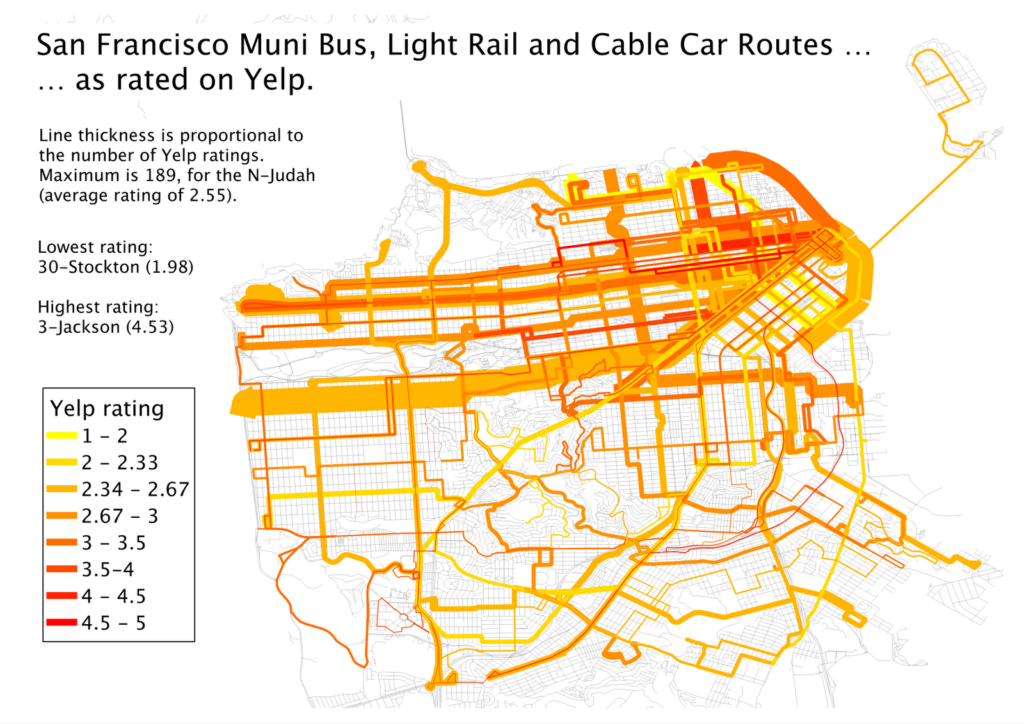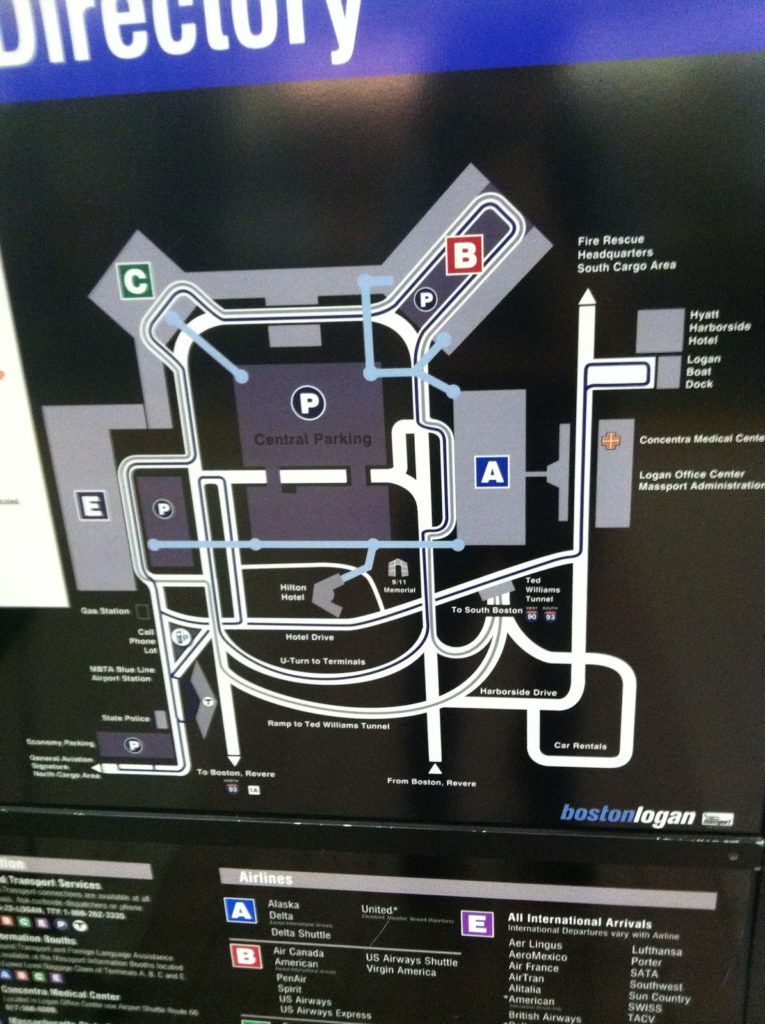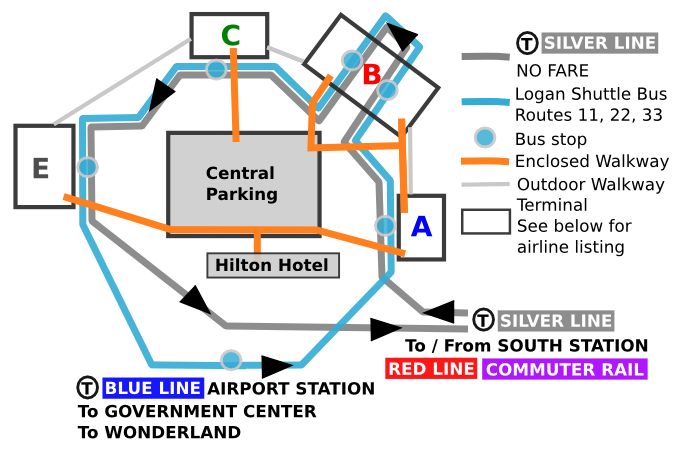 |
| Yelp-rated routes in Boston. Click to embiggen. |
I noticed a while ago—as did some other folks—that Yelp users have been, for some time, rating transit lines. I was intrigued. Here was really interesting data about how people felt about different transit lines, distilled in to a simple 1-to-5 rating. While not every line was ranked in Boston (my first search) there were plenty that were, and I compiled a list of routes, star-ratings and the number of Yelps.
In Boston, only some routes were rated, and they were, not surprisingly, centered in the more student- and hipster-centric part of the city. For instance, no bus line in Dorchester or Mattapan got Yelped, but most in Cambridge and Somerville have many reviews. I figured the best way to show these data was on a map, and after some machinations (especially in resorting the shapefile so the thinner lines would display on top of the thicker ones) I got the map above. It’s pretty cool—click it to enlarge. (Here’s the full MBTA system map if you’re not familiar with the lines; I left off route numbers for clarity.)
But I realized that pretty cool wasn’t cool enough. There was probably a much richer data set out there. Boston has about 750 Yelp reviews, 450 of those for rail lines. Was there city with a wired-in community, lots of bus and transit routes, and high transit ridership? Did I just describe San Francisco to a T? And, voila, there are nearly 2000 Yelp reviews of transit lines in San Francisco, at least one (and usually many more) for nearly every line Muni runs (see exceptions below). (Here’s the Muni system map.)
 |
| Muni Lines, as reviewed by Yelp. Click to Embiggen. |
 |
| San Francisco inset. Click to embiggen. |
That. Is. Sexy. The N-Judah has nearly 200 reviews. Wow. And in case the downtown area is too clustered for you, there’s an inset to the right.
I also realized that I had a pretty fun data set here, too. I went to a talk by Jarrett Walker the other day at MIT where he mentioned, amongst other things, that we should not focus on the technology used for transit, but whether if fulfills the mission of getting people from one place to another. In San Francisco, we have a jumble of buses, trolleybuses, streetcars and even cable cars and we have a pretty good way of quantifying whether they are accomplishing the job of transit. (In Boston, even though the B Line serves tens of thousands of passengers a day it manages a 1.36 Yelp rating—remarkable as the lowest possible rating is 1. None of its 34 raters give it a 4 or a 5. Still, it moves a lot of people marginally faster than they could walk.)
First, I averaged the ratings by technology type. Trolleybus route get more reviews than bus routes, probably because they are more heavily used. The average rating for these, however, is quite similar. (The average is a straight average of each line, the weighted average weighs more frequently-rated lines by the number of ratings). Cable cars and PCCs (F-Marked and Wharves) have higher ratings but many are likely by tourists. Light rail lines, however, are frequently rated, and given low ratings, significantly lower than the bus routes.
| Vehicle type |
Routes |
Avg Reviews |
Avg Stars |
Weighted Avg |
| Bus |
39 |
22 |
3.03 |
2.77 |
| Trolleybus |
12 |
41 |
2.95 |
2.79 |
| Cable Car |
3 |
64 |
3.81 |
3.87 |
| PCC |
1 |
114 |
3.42 |
3.42 |
| Light Rail |
5 |
65 |
2.31 |
2.43 |
A forthcoming post will compare local and express bus routes. (Hint: people like riding expresses more than locals.)
I am so interested in San Francisco’s Yelp bus ratings that I’ve tabled the whole of the network.
| Line |
Vehicle |
Stars |
# Ratings |
|
Line |
Vehicle |
Stars |
# Ratings |
| 1 |
Trolleybus |
2.96 |
78 |
|
48 |
Bus |
2.71 |
17 |
| 2 |
Bus |
2.53 |
26 |
49 |
Bus |
2.33 |
40 |
| 3 |
Trolleybus |
4.53 |
17 |
52 |
Bus |
2.5 |
8 |
| 5 |
Trolleybus |
2.73 |
55 |
54 |
Bus |
2.6 |
10 |
| 6 |
Trolleybus |
2.88 |
16 |
66 |
Bus |
4 |
1 |
| 9 |
Bus |
2.42 |
26 |
67 |
Bus |
3.4 |
5 |
| 10 |
Bus |
3 |
24 |
71 |
Bus |
2.56 |
27 |
| 12 |
Bus |
3.33 |
15 |
108 |
Bus |
2.5 |
16 |
| 14 |
Bus |
2.55 |
44 |
01AX |
Bus |
3.67 |
6 |
| 17 |
Bus |
3.67 |
6 |
01BX |
Bus |
3.31 |
13 |
| 18 |
Bus |
3.25 |
16 |
08X |
Bus |
2.56 |
18 |
| 19 |
Bus |
2.66 |
41 |
14L |
Bus |
4 |
3 |
| 21 |
Trolleybus |
3.58 |
31 |
14X |
Bus |
4 |
6 |
| 22 |
Trolleybus |
2.74 |
92 |
28L |
Bus |
4.33 |
3 |
| 23 |
Bus |
3 |
9 |
30X |
Bus |
3.2 |
35 |
| 24 |
Trolleybus |
2.81 |
32 |
31AX |
Bus |
3.56 |
9 |
| 27 |
Bus |
2.07 |
28 |
31BX |
Bus |
3.75 |
8 |
| 28 |
Bus |
2.48 |
42 |
38AX |
Bus |
3.71 |
14 |
| 29 |
Bus |
2.5 |
36 |
38BX |
Bus |
3.29 |
7 |
| 30 |
Trolleybus |
1.98 |
82 |
38L |
Bus |
3.44 |
61 |
| 31 |
Trolleybus |
2.48 |
23 |
71L |
Bus |
3.5 |
10 |
| 33 |
Trolleybus |
3.24 |
33 |
California |
Cable Car |
4.13 |
69 |
| 36 |
Bus |
2.1 |
10 |
F |
PCC Streetcar |
3.42 |
114 |
| 37 |
Bus |
3.42 |
12 |
J |
Light Rail |
2.49 |
45 |
| 38 |
Bus |
2.45 |
119 |
KT |
Light Rail |
2.13 |
23 |
| 41 |
Trolleybus |
2.82 |
17 |
L |
Light Rail |
2.13 |
38 |
| 43 |
Bus |
2.82 |
28 |
M |
Light Rail |
2.23 |
31 |
| 44 |
Bus |
2.83 |
24 |
N |
Light Rail |
2.55 |
189 |
| 45 |
Trolleybus |
2.62 |
21 |
Powell-Hyde |
Cable Car |
3.78 |
99 |
| 47 |
Bus |
2.13 |
23 |
Powell-Mason |
Cable Car |
3.52 |
25 |
The only lines not Yelped are the 35-Eureka and 56-Rutland. These lines have 30-minute headways (as does the 17-Parkmerced, see this route service chart with headways for all lines) while most lines in San Francisco have service every 15 minutes or better.
Next up: New York’s subways. And beyond.





